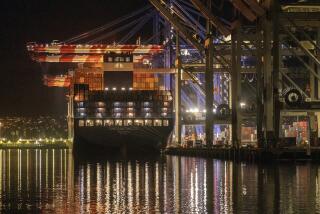Mooring Tall Ships Was a Tall Order
- Share via
Perhaps the best view Sunday of the tall ships motoring into Dana Point Harbor was on the sun deck at Michael’s Supper Club. Until the cannon went off.
“The cannon scared the pants off of us,” muttered a still-shaken Doug McKenzie, 28. “We dropped our cocktails.” And with that he, his wife, Michelle, and two friends hoisted their Irish coffees and cheered Pilgrim II.
“I raised my red flag and waved,” Michelle McKenzie giggled. “Here come the boys.”
On Sunday afternoon, at the Orange County Marine Studies Institute in Dana Point Harbor, a grueling five-hour cruise from Newport Beach ended for Pilgrim, Californian and five other tall ships that docked in Dana Cove.
Anniversary Commemoration
The ships had pushed off from Seal Beach on Saturday for a two-day celebration of the county’s 100th anniversary. The Tall Ships Festival is one of the main events of the yearlong Orange County Centennial.
The ships had spent the night in Newport Bay and were ushered south Sunday morning with a 100-gun salute and encouragement from county Supervisor Thomas F. Riley.
Crews in colorful 19th-Century sailor garb manned the rigging en route and performed boarding at sea, which involves firing a cannon shot from one ship across the bow of another.
“Everybody jumped out of their seats at that cannon,” said Jim Spencer, general manager of Michael’s Supper Club, overlooking Dana Cove.
No Place to Park Cars
The throng that crammed itself into the small harbor to greet the ships found that there wasn’t a place to park. It got so crowded at one point that the bridge across the yacht harbor to a narrow, man-made island--containing Michael’s and a statue of Richard Henry Dana II, among other things--was temporarily closed.
“Everybody’s double-parked out there (on the mainland),” said Bob Zumberger, 36, enjoying a cool drink with his wife and two sons at the restaurant.
Then he whispered: “We came here for the valet parking.”
Over near the marine institute, Pilgrim was having its problems. A mooring line in the channel had dropped from its buoy and disappeared into the aquatic slime underwater. Thousands of disappointed onlookers watched Pilgrim turn back out the yachting channel formed by the man-made island and a jetty.
Aided by his jaunty English accent, good-natured Richard Lewis, director of Pilgrim programs, stood ashore on a table and did his best to entertain the crowd over a public address system.
Lending verisimilitude to the 19th-Century atmosphere, two men in friar garb stood before him at attention, flanked on each side by a woman in pseudo-Indian leather dress and one in a black, lacy get-up that suggested a Spanish origin.
Lewis told a questioner that when Pilgrim and Californian actually arrive for good, there will be a “brouhaha, bit of contretemps about whiskey and revenue, and then they throw the hides.”
Throwing the hides was what the original Pilgrim crew did in the 1830s to unload the cargo of cattle hides that they brought down from ranches in Northern California. Pilgrim II is a replica of the square-rigger on which Dana worked in 1834-36, an experience that led him to write “Two Years Before the Mast” in 1840. A Danish craft was rebuilt as Pilgrim II in 1975.
Mooring Chain Found at Last
Finally, Lewis’ face brightened. The mooring chain had been found. There was a crackle of radio chatter between a Coast Guard officer behind him and Pilgrim’s skipper. At the channel entrance, just visible above Michael’s Supper Club, the mast tips of a tall ship poked into view.
“After trying to manage the moorings and that panic, this is all right,” Lewis said with a smile.
More to Read
Sign up for The Wild
We’ll help you find the best places to hike, bike and run, as well as the perfect silent spots for meditation and yoga.
You may occasionally receive promotional content from the Los Angeles Times.






